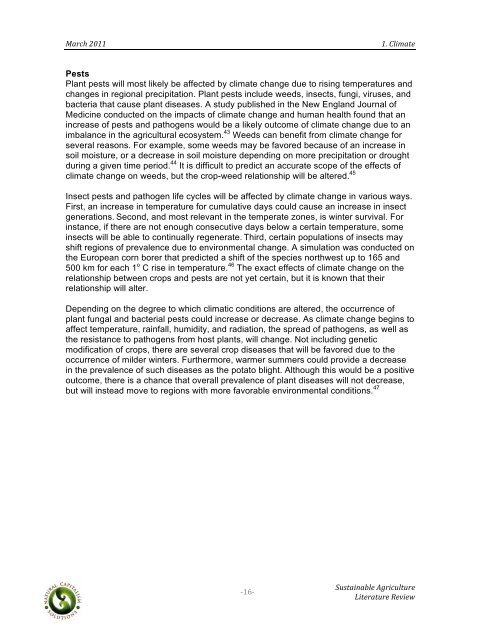Sustainable Agriculture Literature Review - Boulder County
Sustainable Agriculture Literature Review - Boulder County
Sustainable Agriculture Literature Review - Boulder County
Create successful ePaper yourself
Turn your PDF publications into a flip-book with our unique Google optimized e-Paper software.
! ! !!<br />
"#$%&!'())! !!!!!!!!!!!!!!!!!!!!!!!!!!!!!!!!!!!!!!!!!!!!!!!!!! )=!>1.;#-2!<br />
Pests<br />
Plant pests will most likely be affected by climate change due to rising temperatures and<br />
changes in regional precipitation. Plant pests include weeds, insects, fungi, viruses, and<br />
bacteria that cause plant diseases. A study published in the New England Journal of<br />
Medicine conducted on the impacts of climate change and human health found that an<br />
increase of pests and pathogens would be a likely outcome of climate change due to an<br />
imbalance in the agricultural ecosystem. 43 Weeds can benefit from climate change for<br />
several reasons. For example, some weeds may be favored because of an increase in<br />
soil moisture, or a decrease in soil moisture depending on more precipitation or drought<br />
during a given time period. 44 It is difficult to predict an accurate scope of the effects of<br />
climate change on weeds, but the crop-weed relationship will be altered. 45<br />
Insect pests and pathogen life cycles will be affected by climate change in various ways.<br />
First, an increase in temperature for cumulative days could cause an increase in insect<br />
generations. Second, and most relevant in the temperate zones, is winter survival. For<br />
instance, if there are not enough consecutive days below a certain temperature, some<br />
insects will be able to continually regenerate. Third, certain populations of insects may<br />
shift regions of prevalence due to environmental change. A simulation was conducted on<br />
the European corn borer that predicted a shift of the species northwest up to 165 and<br />
500 km for each 1 o C rise in temperature. 46 The exact effects of climate change on the<br />
relationship between crops and pests are not yet certain, but it is known that their<br />
relationship will alter.<br />
Depending on the degree to which climatic conditions are altered, the occurrence of<br />
plant fungal and bacterial pests could increase or decrease. As climate change begins to<br />
affect temperature, rainfall, humidity, and radiation, the spread of pathogens, as well as<br />
the resistance to pathogens from host plants, will change. Not including genetic<br />
modification of crops, there are several crop diseases that will be favored due to the<br />
occurrence of milder winters. Furthermore, warmer summers could provide a decrease<br />
in the prevalence of such diseases as the potato blight. Although this would be a positive<br />
outcome, there is a chance that overall prevalence of plant diseases will not decrease,<br />
but will instead move to regions with more favorable environmental conditions. 47<br />
!<br />
"+'"<br />
!*+,-#./#012!34$.%+1-+$2!<br />
5.-2$#-+$2!627.28!
















